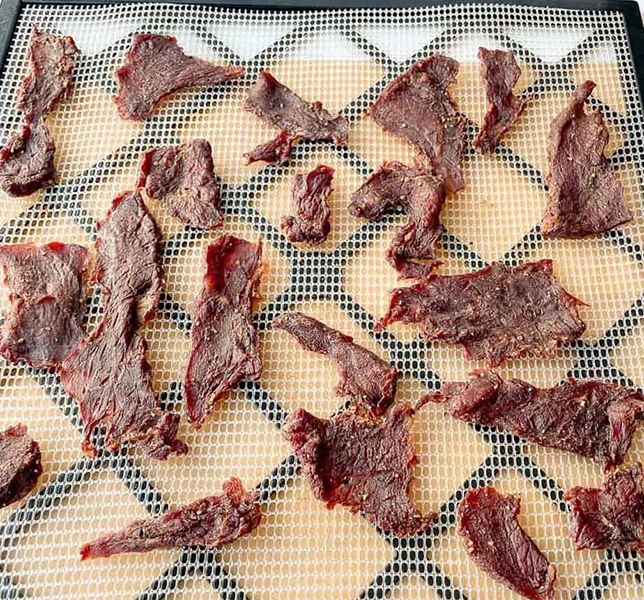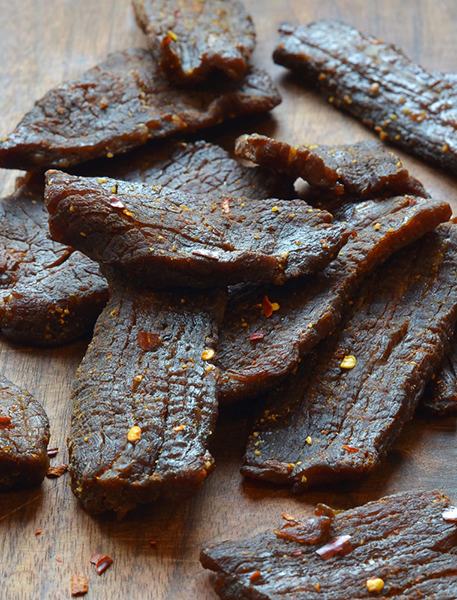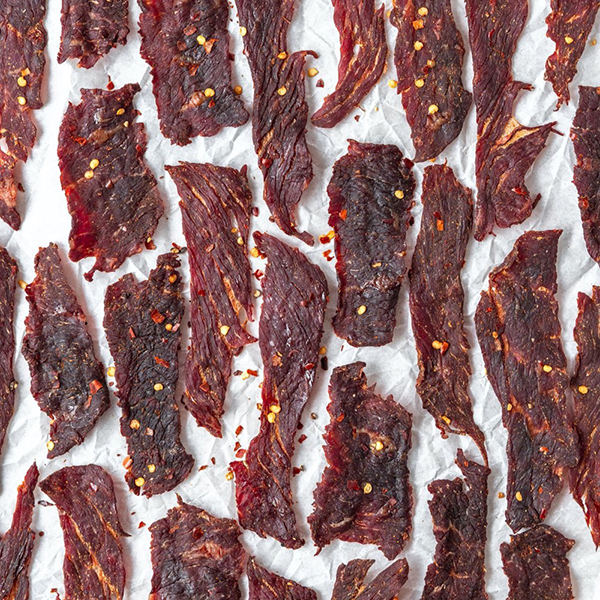
Content Menu
● What is a Food Dehydrator?
>> How Does It Work?
● Benefits of Using a Food Dehydrator for Jerky
● How to Make Jerky in a Food Dehydrator
>> Ingredients
>> Instructions
● Tips for Perfect Jerky
● Common Mistakes When Making Jerky
● Nutritional Benefits of Jerky
● Creative Uses for Jerky Beyond Snacking
● Additional Expansion Suggestions
>> 1. Include More Recipes:
>> 2. Discuss Different Types of Dehydrators:
>> 3. Explore Safety Precautions in Depth:
>> 4. Incorporate Personal Anecdotes or Testimonials:
>> 5. Visuals & Videos:
● Conclusion
● FAQ
>> 1. Can I use any type of meat for making jerky?
>> 2. How long does it take to dehydrate jerky?
>> 3. How do I know when my jerky is done?
>> 4. Can I dehydrate vegetables or fruits in the same machine?
>> 5. How should I store my homemade jerky?
● Citations:
Food dehydrators have gained popularity in recent years, especially among those who enjoy making their own snacks at home. One of the most sought-after uses for food dehydrators is making jerky. This article will explore the process of making jerky using a food dehydrator, the benefits of this method, and answer common questions related to jerky preparation.

What is a Food Dehydrator?
A food dehydrator is an appliance designed to remove moisture from food, thereby preserving it for longer periods. The dehydration process involves circulating warm air around the food at low temperatures, which helps to retain most of the nutrients while eliminating moisture that can lead to spoilage.
How Does It Work?
Food dehydrators typically operate at temperatures ranging from 95°F to 165°F (35°C to 74°C). The appliance uses a fan and heating element to circulate air evenly across the trays, allowing for efficient drying. This method is particularly effective for meats, fruits, vegetables, and herbs.
Benefits of Using a Food Dehydrator for Jerky
Using a food dehydrator to make jerky offers several advantages:
- Healthier Snack Option: Dehydrated foods retain most of their nutrients compared to other cooking methods that may destroy vitamins and minerals.
- Cost-Effective: Making your own jerky can be significantly cheaper than purchasing pre-packaged options, especially when using bulk meat.
- Customizable Flavors: You can experiment with different marinades and spices to create unique flavors tailored to your taste preferences.
- Long Shelf Life: Properly dried jerky can last for months when stored in airtight containers, making it a convenient snack for outdoor activities or road trips.
How to Make Jerky in a Food Dehydrator
Making jerky in a food dehydrator is straightforward. Here's a step-by-step guide:
Ingredients
- 2 pounds of lean meat (beef, pork, turkey, or chicken)
- Marinade ingredients (soy sauce, Worcestershire sauce, garlic powder, onion powder, black pepper, etc.)
- Optional: liquid smoke for added flavor
Instructions
1. Choose Your Meat: Select lean cuts of meat such as eye of round or flank steak. Trim any visible fat as it can lead to spoilage.
2. Slice the Meat: Freeze the meat for about 1-2 hours until firm but not frozen. This makes slicing easier. Cut the meat into thin strips (about 1/4 inch thick) against the grain for tenderness.
3. Prepare the Marinade: In a bowl, mix your marinade ingredients thoroughly. A simple marinade might include:
- 1/4 cup soy sauce
- 1 tablespoon Worcestershire sauce
- 1 teaspoon garlic powder
- 1 teaspoon onion powder
- Optional: red pepper flakes or liquid smoke
4. Marinate the Meat: Place the sliced meat into a resealable bag or container with the marinade. Ensure all pieces are evenly coated. Refrigerate for at least 6 hours or overnight for best flavor absorption.
5. Preheat the Dehydrator: Set your food dehydrator to 160°F (71°C). This temperature is crucial as it ensures that harmful bacteria are eliminated during the drying process.
6. Arrange the Meat on Trays: Remove the meat from the marinade and pat it dry with paper towels to remove excess liquid. Lay the strips out on the dehydrator trays in a single layer without overlapping.
7. Dehydrate: Insert the trays into the dehydrator and allow it to run for about 4 to 6 hours. Start checking for doneness after 4 hours; jerky should be dry but still slightly flexible and should bend without breaking.
8. Store Your Jerky: Once dried, let the jerky cool before storing it in airtight containers or vacuum-sealed bags. Properly stored jerky can last up to several months.

Tips for Perfect Jerky
- Experiment with Marinades: Feel free to try different combinations of spices and sauces to find your perfect flavor profile.
- Check for Doneness Frequently: Since thickness can vary between slices, check each piece regularly after the four-hour mark.
- Use Quality Meat: The quality of meat used will significantly affect the taste and texture of your jerky.
Common Mistakes When Making Jerky
Making jerky can be simple, but there are common pitfalls that can affect your final product:
- Using Fatty Cuts of Meat: Fat does not dehydrate well and can lead to spoilage. Always choose lean cuts.
- Not Marinating Long Enough: For optimal flavor, allow enough time for marination—ideally overnight.
- Overcrowding Trays: Ensure that pieces do not touch or overlap on drying trays; this allows for proper airflow and even drying.
- Ignoring Temperature Guidelines: Always ensure that your dehydrator reaches at least 160°F (71°C) during drying to eliminate any harmful bacteria effectively.
Nutritional Benefits of Jerky
Jerky is not only a delicious snack but also offers several nutritional benefits:
- High Protein Content: Jerky is rich in protein, making it an excellent choice for muscle repair and growth after workouts.
- Low in Carbohydrates: For those following low-carb diets, jerky provides a satisfying snack without excessive carbs.
- Rich in Iron: Beef jerky contains iron which is essential for transporting oxygen in your blood and maintaining energy levels.
Creative Uses for Jerky Beyond Snacking
While jerky is often enjoyed as a standalone snack, there are many creative ways to incorporate it into meals:
- Salads: Chop up jerky and add it as a protein boost in salads instead of croutons.
- Soups and Stews: Add small pieces of jerky into soups or stews for added flavor and protein content.
- Trail Mixes: Combine chopped jerky with nuts and dried fruits for a high-energy trail mix perfect for hiking or road trips.
Additional Expansion Suggestions
1. Include More Recipes:
- Share additional marinades specific to different meats.
- Offer vegetarian alternatives using soy products or mushrooms.
2. Discuss Different Types of Dehydrators:
- Compare various models available on the market.
- Discuss features that are particularly useful for making jerky.
3. Explore Safety Precautions in Depth:
- Provide detailed safety measures when preparing raw meat.
- Discuss how long you should store different types of jerky safely.
4. Incorporate Personal Anecdotes or Testimonials:
- Share personal experiences from users who have successfully made their own jerky.
- Include quotes from chefs or nutritionists about homemade versus store-bought options.
5. Visuals & Videos:
- Suggest including images at each step of preparation.
- Recommend embedding videos demonstrating key techniques like slicing meat or checking doneness.
Conclusion
Using a food dehydrator is an excellent way to make delicious homemade jerky that is both healthy and cost-effective. With just a few simple steps and ingredients, you can create custom-flavored jerky that rivals store-bought options. The versatility of dehydrators also allows you to experiment with various foods beyond jerky, making them a valuable addition to any kitchen.

FAQ
1. Can I use any type of meat for making jerky?
Yes, you can use various types of lean meats such as beef, pork, turkey, or chicken. Just ensure they are trimmed of fat.
2. How long does it take to dehydrate jerky?
Typically, it takes about 4 to 6 hours at 160°F (71°C) depending on the thickness of your meat slices and your dehydrator model.
3. How do I know when my jerky is done?
Jerky is done when it bends without breaking and shows signs of cracking on the surface but remains slightly flexible.
4. Can I dehydrate vegetables or fruits in the same machine?
Absolutely! Food dehydrators are versatile appliances that can be used for drying fruits and vegetables as well as making jerky.
5. How should I store my homemade jerky?
Store your homemade jerky in airtight containers or vacuum-sealed bags in a cool, dark place. It can last several months if stored properly.
Citations:
[1] https://littlehousebigalaska.com/2022/01/beef-jerky-food-dehydrator.html
[2] https://thehouseandhomestead.com/homemade-beef-jerky/
[3] https://peopleschoicebeefjerky.com/blogs/news/how-to-make-beef-jerky-in-a-dehydrator
[4] https://www.foxvalleyfoodie.com/homemade-beef-jerky/
[5] https://www.allrecipes.com/recipe/142948/docs-best-beef-jerky/
[6] https://fyi.extension.wisc.edu/safepreserving/files/2015/07/Making_Safe-Jerky_in_a-Home_Dehydrator.pdf
[7] https://hiphipgourmet.com/recipe-for-beef-jerky-in-a-dehydrator/
[8] https://www.everydaymaven.com/how-to-make-beef-jerky-in-a-dehydrator/
[9] https://www.jerkyholic.com/how-to-make-beef-jerky-with-a-dehydrator/
[10] https://www.youtube.com/watch?v=Wj-xTmebJBQ











